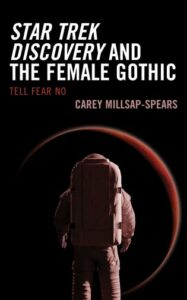
If you’re an English literature nerd who’s anxiously awaiting the final season of Star Trek Discovery in a couple of weeks, I have a great suggestion for how to pass the time. Last fall Carey Millsap-Spears, Professor of Communications and Literature at Moraine Valley Community College, released her first book: Star Trek Discovery and the Female Gothic: Tell Fear No. In this academic analysis, she makes a strong case that, while Star Trek has long drawn inspiration from Gothic literature, Star Trek Discovery draws particularly on the tradition of the “Female Gothic,” including Mary Shelley’s Frankenstein, Ann Radcliffe’s romance novels and Charlotte Brontë’s Jane Eyre.
Millsap-Spears’ introduction is especially well-done, outlining the components that define Gothic literature and the Female Gothic in particular and using examples from across the Star Trek canon to both illustrate the concepts and highlight how pre-streaming Trek drew inspiration from them.
For those like me who weren’t familiar with it, the term “Female Gothic” was originally coined by Ellen Moers in the 1970s to look at literary works by eighteenth and nineteenth century women featuring a singular young woman who is “simultaneously persecuted victim and courageous heroine,” (Frankenstein is included because the major characters are now considered to function in the same vein as other Gothic heroines and can be read as feminine-coded). Much of the book is spent discussing how Michael Burnham fits the framework for this kind of heroine, in a way that streaming-era long narrative arcs made possible. 
“Linking larger Gothic elements to Star Trek happens quite reasonably via the claustrophobic starships’ secret passageways, romances between members of the crews and alien races, uncanny scientific encounters, ethereal landscapes and a longing for the safety of home.”
In addition, for a work to fit into this category it must include a few other tools. First there’s the Sublime, where the protagonist and by implication, the reader, undergoes experiences that trigger heightened emotion and lead to new insights. Think about the joy and wonder a Star Trek character experiences when seeing a new astronomical phenomenon, or the terror the first time we see the Klingon sarcophagus ship in DSC. There’s also the Uncanny (think Mirror Universe doubles, and the idea of the Explained Supernatural—a theme that will be very familiar to Trek viewers because it’s about creating a situation where something seems haunted or uncanny, but which can finally be explained after the heroine (or another protagonist) applies their intellect to the situation. In Discovery just one of the key examples of the explained supernatural that Millsap-Spears digs into is the Red Angel in Season 2.

As we talk about on Women at Warp, Star Trek is also heavily influenced by colonialism and Anglo-American imperialist values. Though it isn’t the focus of her book, Millsap-Spears notes how these dynamics are also present in Gothic fiction and how Discovery and Michael Burnham challenge these traditions:
DSC effectively inverses Star Trek lore and traditions including the white male savior trope and colonial-views of “uninhabited” space to favor a Black, female captain who wears non-regulation, but culturally significant braids, by the third season of the series, and provides a trauma-informed approach to alien encounters and other mysterious phenomenon.
Though there are a couple of typos in the book and references that may have more pedantic Trek fans well-actually-ing (e.g. Kirk and Uhura’s kiss was the first Black/white interracial kiss broadcast in the United States, not the first interracial kiss ever broadcast), these are generally not core to the argument Millsap-Spears is trying to make, which is very well backed-up with examples from literature and Trek.
The conclusion to the volume feels a bit like a mish-mash of ideas that the author wanted to explore but didn’t have time or space to do so in more detail. I would’ve been particularly interested in more incorporation of Queer Gothic theory throughout the volume, as Millsap-Spears does with Afrofuturism and analysis of colonialism/imperialism.

Part of me wished that this book had come out after the show finishes later this spring, because so much great work went into it and it feels unfortunate that the final season wasn’t able to be included. But on the other hand, when many of us are re-watching Seasons 1-4 in preparation for the Season 5 premiere, I really appreciated having this new lens with which to view the series—and the Female Gothic classics that I love.
**
Star Trek Discovery and the Female Gothic: Tell Fear No by Casey Millsap-Spears, was published in October 2023 and is available from Rowman & Littlefield. The author received a complimentary review copy of the book from the publisher in exchange for an honest review.